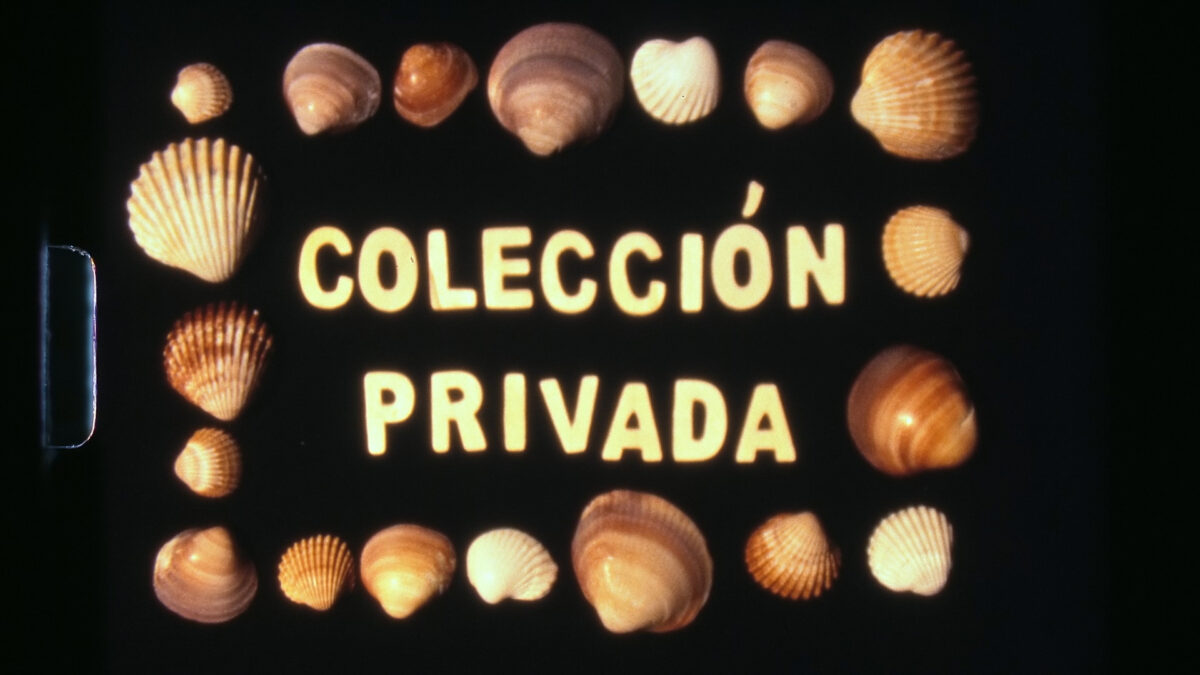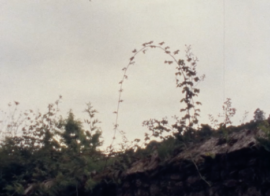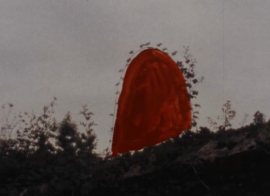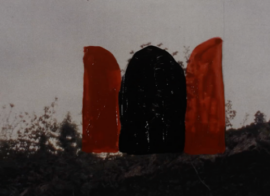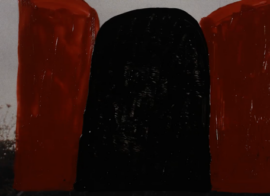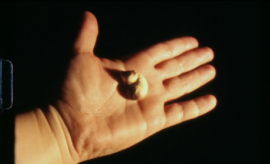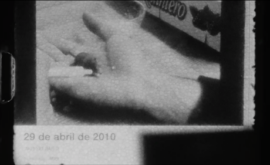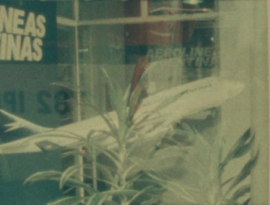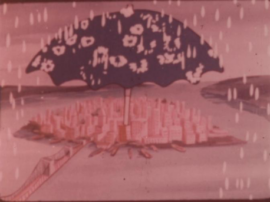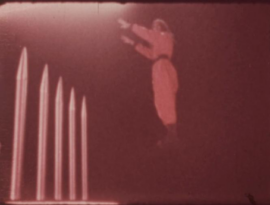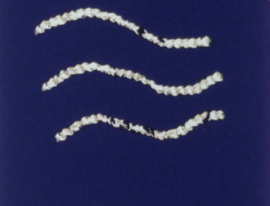Three lines of paint invade the screen tracing a lateral movement, while images on different continents are exchanged behind the lines suggesting that the movement is traveling, crossing borders in rapid communications impossible within the scope of realism. Just like this excerpt from the film Valdedíos (2019), we can imagine Elena Duque crossing from Venezuela, her homeland, to Spain, the place where she lives. Around 2010, other lines of paint with other colors were added in a not-so-linear manner representing her films and their various functions in the film environment since then. Working in parallel as a film critic, she contributed to Revista Lumiére, La Furia Umana, Revista Détour, and as a programmer for S(8) Mostra de Cinema Periférico in La Coruña, Doc’s Kingdom, Seville European Film Festival, LA Film Forum and Xcèntric in CCCB, Barcelona. She began making abstract animations in video and was soon commissioned by film festivals to make vignettes, by music groups to make video clips and other types of on-demand work. In all cases, Duque always guaranteed a sense of play in her style and gaze, as much as the paint line that can go anywhere making some changes in the background.
Her first super-8 camera was a gift from Ángel Rueda, founder and director of S(8). While in her video animations, she mainly works with stop-motion techniques, when she starts working with the analog camera circumstances require reinvention. The small size of the super-8 frames complicates analog stop-motion, calling for more in-camera animation, starting and stopping the film during capture rather than cutting the exposed roll. The use of filmed sequences without interventions increased significantly in her last three films: Valdedíos (2019), Colección Privada (2020), and Mar de Coral (2021).
Valdedíos begins with material filmed in super-8 by Duque during a visit to a monastery in Valdedíos, Spain constructed by Gualterius in the XIII century, in which she animates relationships between clarity and obscurity (an opposition intrinsically related to the monastic architectures) in order to locate apertures to other metaphysical layers of reality. To induce rupture within sequential shots, Duque finds bidimensional plastic points to be transformed in other conventions, materials, dimensionalities, and movements to evoke the use of stop-motion. For example, a falling plant traces a parabolical curve that transforms into a rounded door through her painting intervention. The doors open and black paint emerges from it, covering all the screen. The material world, represented through the diaries of the monastery, reveals itself to be malleable; full of mysteries and possibilities that lie beyond the realistic gaze, stimulating us to pay attention to the abstract and flat dimensions of the images (curves, colors, shapes, etc).
To kick-start the stop-motion in Valdedíos, the director needs to freeze the sequences creating a static image conducive to the effect. After the freezing, she roams freely through fixed photos, animated paintings, and drawings; crossing cultures and traveling around continents and galaxies through the changing of pictures, allowing the metaphysical magnitude of the place to exist in the form of images. The soundtrack that accompanies the journey is a version of Johann Sebastian Bach’s baroque Suite In E Minor For Lute BWW 996 played by the Spanish guitarist Narciso Yepes. The song seems to be played with a strong echo during the animated passages provoking confusion when listening to the calm suite. The animation ceases in the same way it begins, finding a plastic point in the filmed sequences to serve as a chance to return, coming back with the awareness that the whole universe exists in this place.
In her text, Cinco Estampas sobre Robert Breer, published in La Furia Umana, Duque compares the work of American abstract animator Robert Breer, one of her favorite artists, and the first sequence of Jean Vigo’s À propos de Nice (1930). While the first works mainly with stop-motion animation, the second uses filmed sequences and quick transitions to portray the French city of Nice, presenting the arrival of tourists in a small sequence made of toys and stop-motion. Duque points out their use of free associations of ideas in montage as the intersection of these conventionally distinctive but anarchic artists. This study demonstrates fundamentals that would intuitively guide Duque’s experiments in her transition to films that would be analogically filmed and edited.
The desire to transgress is always there for Breer, but not with the spirit of the debater or the creator of scandals, but with that of the children of Zero for conduct: that of breaking the molds and rules to deal with what is truly important, open living paths to wonder and enthusiasm. Exploding a ridiculous official act from a rooftop to provoke a joyful revolution can thus be equated with exploding the perception of color and form by alternating frames of changing colors. The unexpected joy of rupture and the opening of new forms of perception.DUQUE, Elena. ‘Cinco Estampas sobre Robert Breer’. In: La Furia Umana, 2014 (https://www.academia.edu/12014383/Cinco_estampas_sobre_Robert_Breer)
In Colección Privada, she works entirely with super-8 exposing all tricks in a work full of magic and questions. The film brings back the theme of collections she worked on in another film entitled Coleccionismo (2012). On the latter, she presented four collections (vases, clocks, paintings, and plates) divided along the short time of a Super-8 film roll, as a sort of diary film to remember a house in Ontario. In Colección Privada, she makes an inventory of her life showing a series of personal souvenirs as an art gallery, exchanging the diary form for a studio-based method of presenting objects, in film sequences with lighting, framing, positioning, and timing controlled.
It starts with a countdown like in historical cinema, preparing us for a studio film. The 13-minute extension can be divided into four parts, not so strictly distributed but with specific questions in each one. The first presents us pictures of rocks, landscapes, stamps with landscapes, postcards, drawings of animals that move through in-camera stop-motion; small sculptures of animals that can be covered inside Duque’s closed hand, world maps, biology drawings for studies and many lists of visited places. She shows her large collections and small souvenirs saved for personal reasons and unknown affections; a Dadaistic and naïf curatorial work that never justifies its existence, like a kid that plays “opening living paths to wonder and enthusiasm”.
In the second part, Duque reveals herself as a motif to freely animate this vast inventory, pointing out her presence behind the camera in the sequences as someone who chooses, curates, illuminates, frames, and shows her personal tastes, creating an auto-portrait using the objects she owns. It begins with black-and-white pictures of art sculptures made with fruits and vegetables that simulate animals. She plays with color using light to illuminate the pictures and rolling circular filters outside the frame creating an effect that looks like light coming from stained glass or a child’s toy. Back to color film, we see another part of the inventory in which the objects have personal functions or directly refer to Duque’s figure as owner (but of course, not so rigorous): earrings, miniature tools, a rosy old roll of American classical cartoon, milk teeth, old glasses, and medicines, a tattoo, traces on her skin, napkins, cards that are quickly animated through in-camera stop-motion, more stamps (with sports, animals, country, transports), 3×4 photos and some passports.
The third part is a natural ontological sequence that expands the film’s discourse from the format of a study to a manifest. It is composed only of diaries filmed between 2010 and 2013, within a frame that contains the date of the document on the edges of the images. The fragments appear chronologically. Some are filmed by Duque, in some others she’s in front of the camera. One of the first images shows a very small animal in her hand being fed by her, in a similar image from the first section in which a souvenir of a little sleeping kitten is inside her hand. To show the object, Duque opens her closed hand to reveal the sleeper. Like a curtain that opens, she animates using a gesture of her own body. In the first two sections, while avoiding the use of stop-motion, Duque studies forms of inherent animation in the filmed fragments (like her hand opening) and the intervals evoked by the cuts.
In her most recent films, she seems not just to animate, but to find the animations that implicitly make the world spin. When the diaries dominate the third part, a question is quickly raised: what survives from animation? The film is not dealing with the static anymore. If in the second part, the sign of Duque curating and moving the present objects animates the shots, now we have the same concept applied to her old film fragments, so, animation and gaze are finally allied and implicated. Behind this irreverent associative freedom is a perception of the world intrinsically related to animation, like a montage that works as a series of synapses passing from image to image that can go anywhere. At the end of this procedure, film frees itself as its own body, full of inner movements that transparently give life to the work and combine with the rolling movement of the projector.
The fourth and final part goes to the real world at Duque’s home. The gaze is free to animate through stop-motion, like Breer, and film sequences, like Vigo. Dresses, hanging on a clothesline, change through stop-motion. Her cats lie down, resting on the calmness of film fragments. A man is framed very closely so that his beard and hair occupy almost the entire image. Does Duque own him like the dresses and, perhaps, the cats? The move toward reality takes the politics of owning, presented especially in the first two studio parts, to new levels that propose many questions to the viewer. We see Duque in total freedom, animating her drawings, and pieces of paper; the color filter used before is finally inside the frame revealing itself to be a toy, and filming in a single movement the static blue sky and the movements of the blue sea. Is she animating the landscapes or finding the natural animations that compose reality? In case of doubt, she places a transparent glass signed “Elena Duque 2020” between the lens and the natural landscape and finishes the film with her signature. The animated gaze is free in the face of the vastness and beauty of the world itself.
The sea that closes Colección Privada makes room for her next film, Mar de Coral. Here, Duque operates elaborating on the freedom she achieved with Super 8 in the last film, as she works only with filmed fragments, some made by her, some by others but collected by her; more American classical cartoons, and scratches made directly on film strips. The montage plays freely with these fragments, moving from one to another through varied associations, guided by the fascination for the movements that each one contains.
It begins with trees filmed from below, whose leaves are illuminated by the reflections of water. In the next image, we see the sea, creating a suggestive association of continuity between the water and the reflection, through a pan on a boat that shows the surface of the sea and the series of corals that are underwater. Next, we see another shot from below the tree with water reflections, and then, an underwater shot. Clearly, the first and third shots were made by Duque, while the second and fourth, are old rosy documents from an unknown camera operator, maybe a TV program or a tourist advertisement. Her formal play is exposed here: shots of the coral sea illuminate and animate the other shots. To unify two fragments is to create a synapse, finding the transparency of the animations contained in the world, exchanging between her diaristic colorful shots and others’ rosy film materials. In Mar de Coral, Duque surpasses animation, exposing that her gaze and style are driven by animation itself, like the third part of Colección Privada proposed. The action of animate is free of the idea of an effect applied to the images, it is now at the core of her intuition expressed through montage, from sequence to sequence, in constant motion.
From an old document of a bird flying on the surface of the water, she cuts to a diary shot of a decorative duck on the window of a house. From the top of a building, she cuts to a fiction film shot of a person falling from a roof. Some junctions are obvious, some are derived from similar movements or color tones and others are completely mysterious; in all cases, the film finds through fascination a calm and pleasurable continuation of movements and rhythms that progressively amplifies the possibilities of themes. It composes a personal and secret narrative. Sometimes it plays like Marie Menken’s irruption of lights, sometimes like Warren Sonbert’s linguistic combinations in polyvalent montage, always with Margaret Tait’s sense of direction in which she can make a film about anything and flows as a kind of decompensated collage, no matter what.
Challenging the idea of animation through the circumstances of Super 8 support in her last films, Duque found in Mar de Coral a style of filming and editing intrinsically related to animation. Her gaze mixes the perceptive acts of animating and capturing animation that moves the world. Her montage perpetuates these animations with a certain transparent and continuous rhythm through junctions that freely propose associations like synapses that form a body of film. Transparency in her works is achieved by the awareness of herself as the mediator and its consequent erasure through underlining the objectivity of the film itself. For the next film, Duque is again in front of the vastness of the sea and sky, having now achieved a strong and joyful style, free to openness by its own means. She’s not adapted to safe authorial places, changing from work to work, starting from what was achieved in previous films, she goes in search of new achievements in her new works, challenging what was consolidated before. After a film so moved through fascination as Mar de Coral, Duque’s newest film entitled Ojitos mentirojos (little lying eyes) challenges the spectator’s trust in the image on every shot and every cut, treating cinema as a trompe l’oeil machine.
For Duque, making films is more about work and play, “the joy of rupture”, than about authorship. The path taken by the films is winding and thought-provoking, presenting different works that join hands through questions raised from the relationship between animation and analog film on small supports. However, her recent expanded performances entitled HACER/VER (2023) already shake the firmament of this duality. Considering a supposed union between her directing and programming work, it is possible to suggest that, in the chronology of her filmography, Duque seeks to unite increasingly varied forms, hindering the idea of linearity and progression in favor of the idea of approximation, and why not, animation.
